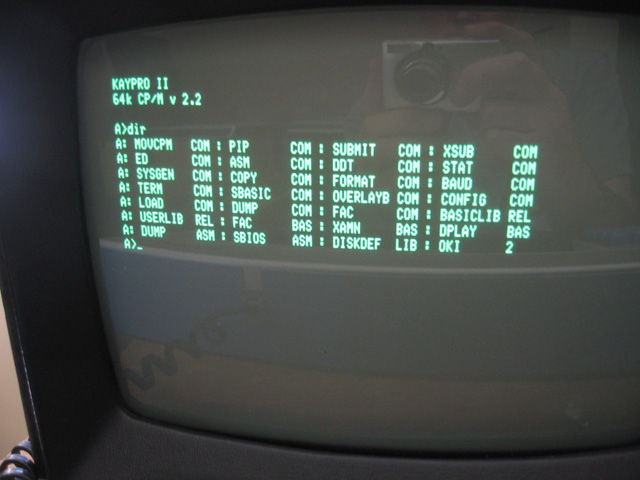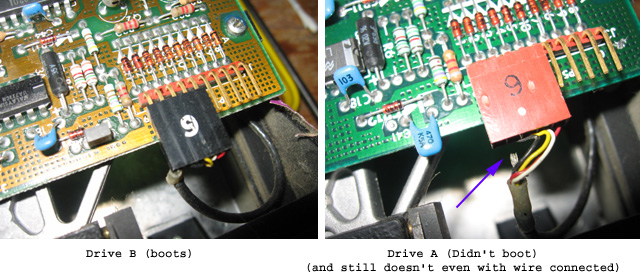tezza
Veteran Member
Hi,
I've recently acquired a Kapryo II with drive issues as posted about in the collections thread.
Today I pulled the machine apart to inspect the drives. They are Tandon TM 100-1A models. There is little about them on the web.
Anyway, I disassembled them and lubed the rails of both, reconnected and tried to boot. Same result...the disk could not be read.
I decided to swap the drives over. Knowing that there is both a terminator block and drive number selector to change somewhere, I looked for these. I found them (see below) and exchanged them. Interestingly, what I'm assuming is the terminator (disguised as a blue IC) was on drive B not drive A? Even though drive A was last in the chain. Is this usual?

Anyway...
So I booted with the swapped drive (was B now A) and volia! The drive spun for a second and up came CP/M 2.2. Typing DIR revealed the below..

What a beautiful sight!
So, drive A seemed to have issues and Drive B was ok (actually maybe not but more on that later).
I looked more closely at Drive A. Ah ha...a broken wire on a plug!

I figured this was the problem but after re-attaching the wire, and reconfigring it as Drive A again, it STILL refused to boot a disk. It can't read a directory as B either. Obviously there is a non-visible fault with this one. I figured I might have broken that wire myself when I removed the plug to unscrew the circuit board when I cleaned it. It is strange though, as it was almost as if that wire was NEVER attached? The flex was kind of flat (not pointed) and there were no remenants of wire in the pin itself?
Ok, anyway, I have a least one working drive right?
Well...I'm not sure. Typing a DIR showed all those programs. However, I can't get any of them to load. The disk just spins and spins. So either..
I will look at the other images when I get some more time.
Hopefully it is hypothesis number 3.
Tez
I've recently acquired a Kapryo II with drive issues as posted about in the collections thread.
Today I pulled the machine apart to inspect the drives. They are Tandon TM 100-1A models. There is little about them on the web.
Anyway, I disassembled them and lubed the rails of both, reconnected and tried to boot. Same result...the disk could not be read.
I decided to swap the drives over. Knowing that there is both a terminator block and drive number selector to change somewhere, I looked for these. I found them (see below) and exchanged them. Interestingly, what I'm assuming is the terminator (disguised as a blue IC) was on drive B not drive A? Even though drive A was last in the chain. Is this usual?

Anyway...
So I booted with the swapped drive (was B now A) and volia! The drive spun for a second and up came CP/M 2.2. Typing DIR revealed the below..

What a beautiful sight!
So, drive A seemed to have issues and Drive B was ok (actually maybe not but more on that later).
I looked more closely at Drive A. Ah ha...a broken wire on a plug!

I figured this was the problem but after re-attaching the wire, and reconfigring it as Drive A again, it STILL refused to boot a disk. It can't read a directory as B either. Obviously there is a non-visible fault with this one. I figured I might have broken that wire myself when I removed the plug to unscrew the circuit board when I cleaned it. It is strange though, as it was almost as if that wire was NEVER attached? The flex was kind of flat (not pointed) and there were no remenants of wire in the pin itself?
Ok, anyway, I have a least one working drive right?
Well...I'm not sure. Typing a DIR showed all those programs. However, I can't get any of them to load. The disk just spins and spins. So either..
- This drive is also faulty (but it boots no problem, every time and display a DIR???).
- The programs did not write out correcty onto the disk, from the PC containing the image. (although it was a 360k drive and all tests seemed fine).
- The image itself was just a CP/M boot disk and those programs were not actually on the disk. However, their directory entries were.
I will look at the other images when I get some more time.
Hopefully it is hypothesis number 3.
Tez
Last edited:

